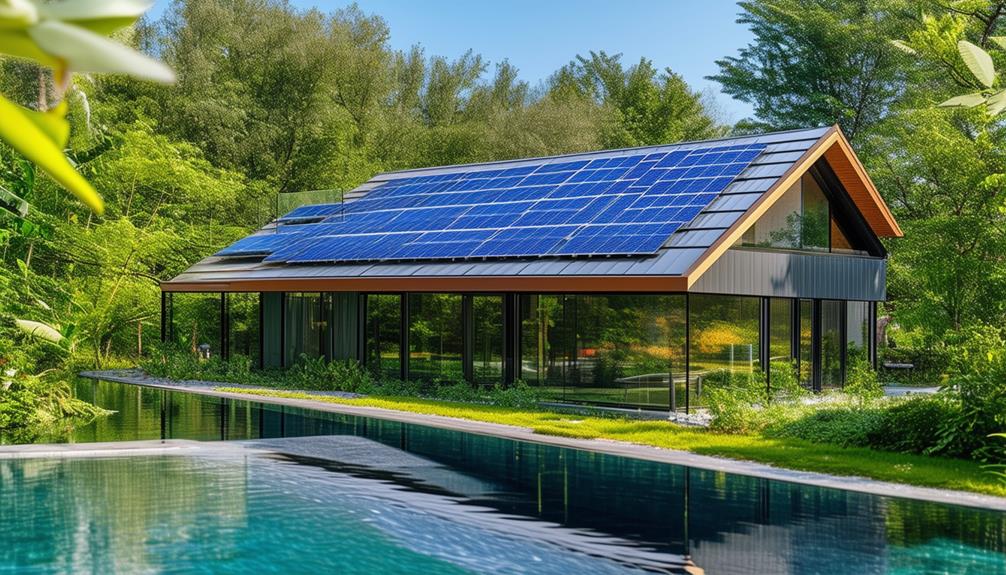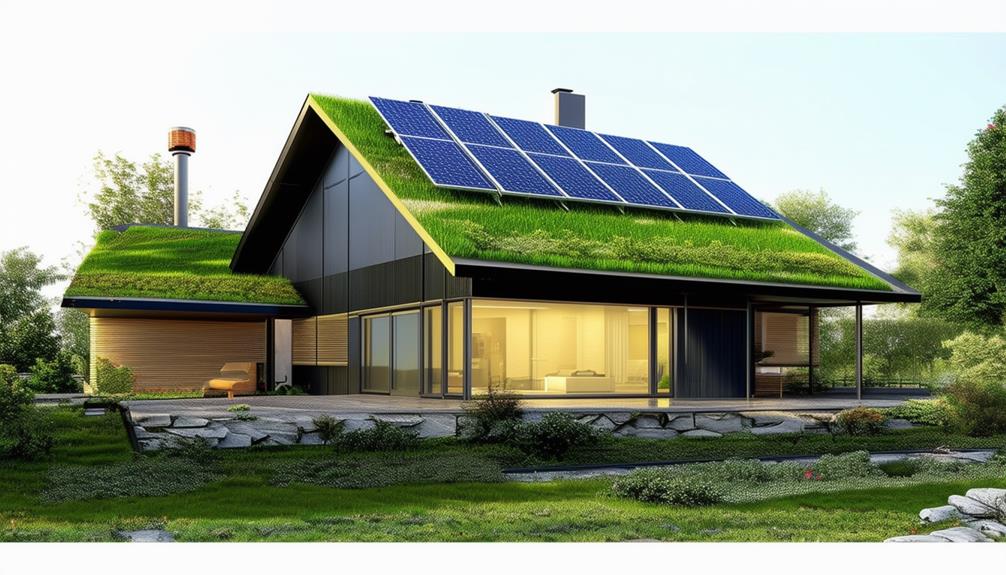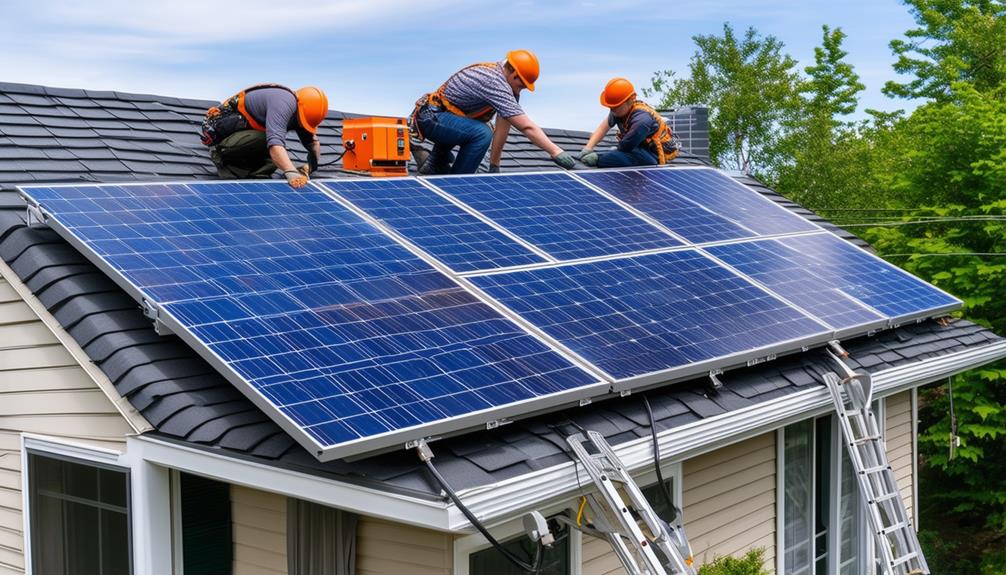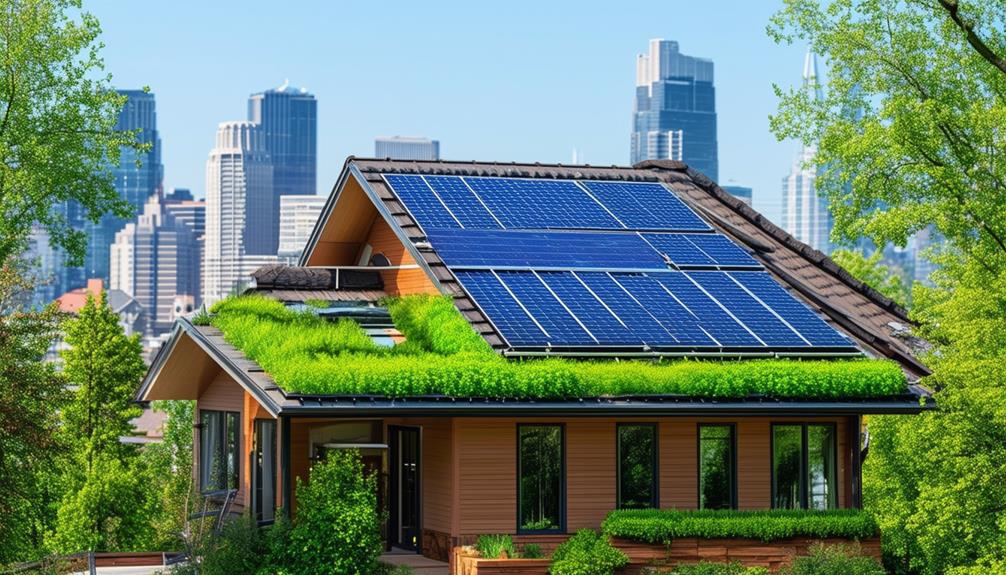Choose energy-efficient roofing materials for long-term savings and eco-friendly impact. Opt for reflective roof coatings to reduce indoor temperatures and energy usage significantly. Consider solar panel integration for harnessing renewable energy with proper installation and maintenance. Explore green roof systems for insulation, stormwater management, and urban sustainability. Trust reputable contractors for correct installation and warranties. Maintain energy efficiency with seasonal inspections, debris clearance, and prompt leak repairs. Secure your budget and help the environment with smart roofing choices.
Benefits of Energy-Efficient Roofing Materials

Choosing energy-efficient roofing materials can lead to significant cost savings over time due to their ability to reduce energy consumption and improve overall building insulation. These materials offer long term savings by lowering heating and cooling costs through better insulation properties. Additionally, eco-friendly benefits are achieved by reducing the carbon footprint of the building.
Energy-efficient options such as cool roofs, green roofs, and solar panels not only provide cost savings but also contribute to environmental sustainability. Cool roofs reflect sunlight and absorb less heat, reducing the need for air conditioning and prolonging the roof's lifespan. Green roofs add insulation, reduce stormwater runoff, and provide aesthetic appeal while improving air quality. Solar panels harness renewable energy, further decreasing energy consumption and offering potential savings through net metering programs.
Types of Energy-Efficient Roofing
When considering energy-efficient roofing options, you can explore various types tailored to meet your specific needs. Reflective roof coatings help to deflect sunlight and reduce heat absorption, lowering cooling costs. Solar panel integration allows for harnessing renewable energy sources, while green roof systems offer eco-friendly solutions that promote insulation and reduce urban heat island effects.
Reflective Roof Coatings
Reflective roof coatings play a crucial role in enhancing the energy efficiency of buildings by reducing heat absorption and improving overall insulation. Cool roof coatings, a type of reflective roof coating, are designed to reflect sunlight and absorb less heat than traditional roofing materials. By implementing cool roof coatings, buildings experience reduced indoor temperatures, leading to lower energy usage for cooling systems. This results in significant energy savings, making cool roof coatings a cost-effective and sustainable solution for improving a building's energy efficiency.
The reflective properties of these coatings also help in extending the lifespan of the roof by minimizing heat-induced damage, such as thermal expansion and contraction. Additionally, by reducing the heat island effect in urban areas, cool roof coatings contribute to a more comfortable environment and lessen the overall energy demand during peak hours. Incorporating reflective roof coatings into building designs is a practical way to promote energy efficiency and environmental sustainability.
Solar Panel Integration
To further enhance energy efficiency and sustainable practices in buildings, consider integrating solar panels as part of the roofing system. Solar panel efficiency is an important factor in maximizing energy production while maintaining rooftop sustainability. When choosing solar panels for integration, opt for high-performance models that can convert a greater percentage of sunlight into electricity. Monocrystalline panels are known for their efficiency and longevity, making them a popular choice for rooftop solar installations. Additionally, polycrystalline panels offer a cost-effective option without compromising greatly on efficiency.
To guarantee top solar panel efficiency, proper installation and orientation are essential. Panels should be positioned to receive maximum sunlight exposure throughout the day, typically facing south in the northern hemisphere. Regular maintenance, such as cleaning debris and ensuring panels are free from shading, will help maintain peak efficiency. By integrating high-performance solar panels into your roofing system, you can significantly reduce energy costs and contribute to a more sustainable environment.
Green Roof Systems
Consider incorporating various types of green roof systems as part of your energy-efficient roofing strategy to optimize sustainability and energy savings. Green roofs offer numerous benefits, including reducing urban heat island effect, improving air quality, and enhancing stormwater management by absorbing rainwater.
- Green Roof Benefits: Green roofs provide insulation, reducing the need for heating and cooling, which translates into energy savings. They also extend the lifespan of the roof membrane by protecting it from UV radiation and temperature fluctuations.
- Installation: Installing a green roof involves several steps, including waterproofing, adding a root barrier, and creating a drainage layer. The selection of appropriate plants is essential for the success of the green roof.
- Urban Sustainability, Stormwater Management: Green roofs contribute to urban sustainability by creating green spaces in cities, promoting biodiversity, and reducing the heat island effect. They also help manage stormwater by absorbing and filtering rainwater, reducing runoff and strain on drainage systems.
Cost-Saving Advantages of Energy-Efficient Roofing

Maximizing cost savings through the use of energy-efficient roofing materials involves strategic selection based on factors such as insulation properties, durability, and long-term performance. Energy-efficient roofing solutions offer significant advantages regarding energy savings and long-term investment. By choosing sustainable materials and eco-friendly solutions, you not only reduce your environmental footprint but also benefit from lower energy costs over time.
Investing in energy-efficient roofing materials may require a higher upfront cost compared to traditional roofing options. However, the long-term savings generated through reduced energy consumption often outweigh this initial investment. These materials are designed to provide better insulation, reducing the need for constant heating or cooling, which in turn leads to lower energy bills.
Moreover, energy-efficient roofing systems are known for their durability and longevity, minimizing the need for frequent repairs or replacements. This aspect further contributes to cost savings in the form of reduced maintenance expenses. By opting for sustainable and eco-friendly roofing solutions, you can enjoy both financial benefits and environmental stewardship.
Environmental Impact of Energy-Efficient Roofing
Energy-efficient roofing materials not only provide cost-saving advantages but also have a significant environmental impact worth considering. When evaluating the environmental benefits of energy-efficient roofing, several key factors come into play:
- Energy Savings: Energy-efficient roofing materials help reduce the energy consumption of buildings by improving insulation and reflecting sunlight, thereby decreasing the need for heating and cooling systems.
- Sustainability: By using sustainable materials in energy-efficient roofing, such as recycled content or materials that can be easily recycled at the end of their lifespan, you contribute to a more sustainable construction industry.
- Carbon Footprint: Energy-efficient roofs can lower the carbon footprint of buildings by reducing greenhouse gas emissions associated with energy use. This reduction in emissions is essential for combating climate change and promoting environmental stewardship.
Considering these aspects, opting for energy-efficient roofing not only benefits you economically but also plays an important role in environmental conservation and sustainability.
Installation Process for Energy-Efficient Roofing

During the installation process for energy-efficient roofing, attention to detail and proper execution are essential to guaranteeing peak performance and longevity of the roofing system. Hiring experienced roofing contractors is vital to ensure a professional installation that maximizes energy savings and insulation benefits. These contractors are well-versed in the specific requirements of energy-efficient roofing materials and can make sure that the installation is done correctly to reap the full benefits.
Additionally, reputable roofing contractors often provide warranties for their work, which can offer you peace of mind knowing that any issues that may arise post-installation will be taken care of. These warranties vary in length and coverage, so it's important to discuss these details with your contractor before the installation begins.
Maintenance Tips for Energy-Efficient Roofing
To guarantee the longevity and efficiency of your energy-efficient roofing, conduct seasonal roof inspections regularly. Clearing debris such as leaves and branches from your roof can help prevent water pooling and potential damage. It is essential to address any leaks promptly to avoid further deterioration of your roofing system.
Seasonal Roof Inspections
Regular roof inspections are essential for maintaining the energy efficiency of your roofing system and ensuring its longevity. To keep your roof in top condition throughout the year, follow these seasonal maintenance tips:
- Winter Maintenance: During winter, it's important to inspect your roof for any signs of ice dams, snow accumulation, or damage caused by freezing temperatures. Clearing snow and ice promptly can prevent leaks and structural issues.
- Spring Repairs: Once winter has passed, spring is the ideal time to address any damage that may have occurred. Look out for loose or missing shingles, damaged flashing, or signs of water infiltration. Repairing these issues promptly can prevent further damage during the rainy season.
- Summer Check-up: In the summer months, inspect your roof for any signs of heat damage, such as blistering or cracking. Check the seals around vents, chimneys, and skylights to ensure they are intact and not letting hot air into your home. Regular inspections will help you catch any problems early on and maintain the energy efficiency of your roof.
Clear Debris Regularly
Regularly clearing debris is crucial for maintaining the energy efficiency and longevity of your roofing system. Debris such as leaves, branches, and dirt can accumulate on your roof, causing water pooling, blocking drainage systems, and potentially leading to mold growth. To guarantee peak performance of your energy-efficient roofing materials, incorporate regular maintenance practices that include thorough debris removal.
Engage in routine inspections to identify any debris buildup on your roof. Use a leaf blower or a soft-bristle broom to gently remove leaves and smaller debris. Pay close attention to valleys and gutters where debris tends to accumulate the most. By keeping these areas clear, you prevent water from pooling and potentially seeping into your roof structure, which can compromise its energy efficiency.
Scheduled debris removal not only helps in maintaining the efficiency of your roofing system but also contributes to its longevity. By investing time in regular maintenance and debris removal, you actively protect your roof from potential damage and ensure it continues to perform at its best.
Address Leaks Promptly
Clearing debris regularly from your energy-efficient roofing system is essential for peak performance; however, addressing leaks promptly is equally important to prevent potential damage and maintain energy efficiency. When it comes to leak prevention and maintenance tips for your roof, consider the following:
- Regular Inspections: Conduct frequent inspections of your energy-efficient roof to identify any signs of leaks promptly. Look for water stains on ceilings, damp spots on walls, or mold growth, as these can indicate hidden leaks that need immediate attention.
- Prompt Roof Repair: If you notice any signs of a leak, such as missing or damaged shingles, deteriorated flashing, or cracked seals, address them promptly to prevent water from seeping into your home. Timely roof repairs can help avoid extensive water damage and maintain the energy efficiency of your roofing system.
- Water Damage Prevention: Besides fixing leaks promptly, ensure proper insulation and ventilation in your attic to prevent condensation buildup, which can lead to water damage and compromise the efficiency of your energy-efficient roof. By addressing leaks promptly and implementing preventive measures, you can protect your home and save on energy costs.
Energy-Efficient Roofing Rebates and Incentives

Explore available government and utility company programs that offer energy-efficient roofing rebates and incentives to encourage sustainable roofing practices. Rebate programs and tax incentives are commonly offered to homeowners who choose energy-efficient roofing materials. These programs aim to offset the initial cost of installing energy-efficient roofs, making them more accessible to a wider range of individuals. Additionally, some utility companies provide financial incentives for upgrading to energy-efficient roofs, further reducing the financial burden on homeowners.
When considering financing options for energy-efficient roofing projects, it is essential to factor in potential savings calculations. By investing in an energy-efficient roof, homeowners can greatly decrease their energy bills over time due to improved insulation and reduced energy consumption. Calculating these potential savings can help homeowners make informed decisions about which roofing materials to choose and how to finance their projects effectively.
Choosing the Right Energy-Efficient Roofing Material
When selecting energy-efficient roofing materials, consider the specific climate and weather conditions of your region to optimize the performance and sustainability of your roof. Different roofing materials offer varying levels of energy efficiency, durability, and cost-effectiveness. Here are some key points to keep in mind:
- Roofing Material Comparison: Compare the energy efficiency ratings and insulation properties of different roofing materials such as metal, asphalt shingles, clay tiles, or green roofs. Each material has its pros and cons, so choose one that best suits your climate and budget.
- Installation Tips: Proper installation is important for maximizing energy savings and long-term benefits. Ensure that the roofing material is installed correctly, with adequate insulation and ventilation to prevent energy loss and prolong the roof's lifespan.
- Energy Savings, Long Term Benefits: Investing in high-quality energy-efficient roofing materials may have a higher upfront cost but can lead to significant energy savings and long-lasting benefits in terms of reduced utility bills and environmental impact.
Frequently Asked Questions
Can Energy-Efficient Roofing Materials Withstand Extreme Weather Conditions?
Yes, energy-efficient roofing materials can withstand extreme weather conditions. Their durability guarantees resilience against harsh climates, providing long-term performance. Regular maintenance is essential to uphold their effectiveness. These materials are engineered to endure various weather challenges, offering a sustainable solution for your roofing needs. Consider their climate adaptability and performance characteristics when selecting the most suitable energy-efficient roofing material for your location.
Do Energy-Efficient Roofing Materials Require Special Insurance Coverage?
When it comes to insurance coverage for energy-efficient roofing materials, it's important to check with your provider. Some insurance companies may offer specific policies or discounts for these types of roofs due to their durability and potential cost savings. However, maintenance costs for energy-efficient roofing materials could impact insurance coverage requirements. Regular upkeep and inspections may be necessary to maintain the roof's efficiency and longevity, potentially affecting your insurance coverage terms.
Are Energy-Efficient Roofing Materials Compatible With Solar Panel Installations?
When considering solar panel integration, energy-efficient roofing materials can be compatible and beneficial. Certain materials like metal roofs provide a sturdy base for solar panel installation due to their durability and weight-bearing capacity. However, some installation challenges may arise with more delicate materials like clay tiles. Overall, selecting the right energy-efficient roofing material is essential for ensuring a successful and efficient solar panel setup on your roof.
How Do Energy-Efficient Roofing Materials Affect Property Resale Value?
When considering property value impact, energy-efficient roofing materials can greatly enhance resale value. The long term benefits of these materials, such as reduced energy costs and increased sustainability, appeal to environmentally conscious buyers. Additionally, the durability and low maintenance requirements of energy-efficient roofing can attract potential buyers looking for a long-lasting investment. Overall, incorporating energy-efficient roofing materials can positively influence property resale value and attract a wider pool of interested buyers.
Can Energy-Efficient Roofing Materials Be Recycled at the End of Their Lifespan?
When it comes to energy-efficient roofing materials, recycling options play an essential role in reducing the environmental impact. Did you know that approximately 11 million tons of asphalt shingles are discarded each year in the United States alone? Recycling old roofing materials can greatly decrease this waste, preserving natural resources and minimizing landfill usage. Investigating recycling programs for your energy-efficient roofing materials can make a substantial difference in sustainability efforts.
Conclusion
To sum up, when deciding on energy-efficient roofing materials, it's important to take into account their benefits for both your wallet and the environment. By selecting the right roofing material, you can cut down on energy costs and decrease your carbon footprint. With a range of options to choose from and cost-effective advantages to weigh, transitioning to energy-efficient roofing is a wise investment for your home and the planet. So don't hesitate, opt for the eco-friendly alternative and reap the rewards in the long run.




